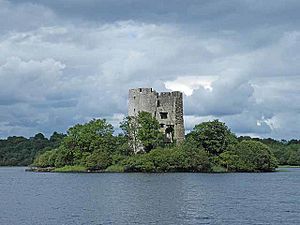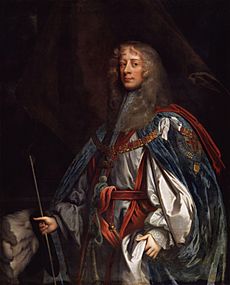Theophilus Jones (soldier) facts for kids
Sir Theophilus Jones (around 1606–1610 to 1685) was an Irish soldier and government worker. He came from a Welsh family and was one of five sons born to Lewis Jones, who was a bishop in the Church of Ireland. His family was very close and important.
Theophilus was also the grandson of James Ussher, a very important church leader in Ireland from 1625 to 1656. In 1648, he married his cousin, Alicia Ussher. His brothers were also well-known: Henry and Ambrose became bishops, while Michael and Oliver were important soldiers and politicians.
We don't know much about Theophilus before the Irish Rebellion of 1641 started. During the Irish Confederate Wars, he first fought with the Earl of Ormond's Royal Irish Army, and later with Oliver Cromwell. When Ireland was part of the Commonwealth of England (from 1653 to 1660), he served as a MP in the Second Protectorate Parliament and Third Protectorate Parliament. Before King Charles II returned to power in 1660, Theophilus and his brother Henry played a key role in making sure Ireland supported Charles II.
Because of his loyalty, he was given important jobs. He joined the Privy Council of Ireland, became the Clerk of the Pells in the Exchequer of Ireland, and was made Scoutmaster of Ireland. He was also elected as an MP for County Meath in the Irish Parliament from 1661 to 1666. After 1664, he mostly stepped back from public life. He passed away in Osbertstown, County Kildare, on January 2, 1685.
Quick facts for kids
Sir Theophilus Jones
|
|
|---|---|

Cloughoughter Castle, which surrendered to Jones in the final action of the Irish War
|
|
| Privy Council of Ireland | |
| In office 1661–1685 |
|
| Scoutmaster General | |
| In office 1661–1685 |
|
| Member of the Irish Parliament for County Meath |
|
| In office May 1661 – April 1666 |
|
| Member of the Third Protectorate Parliament for County of Dublin |
|
| In office January 1659 – April 1659 |
|
| Member of the Second Protectorate Parliament for Westmeath, Longford, and King's County |
|
| In office September 1656 – February 1658 |
|
| Personal details | |
| Born | circa 1606 to 1610 |
| Died | 2 January 1685 Osbertstown, County Kildare |
| Resting place | Naas, County Kildare |
| Nationality | Irish |
| Spouse | Alicia Ussher (1625–1690) |
| Relations | Henry; Michael; Ambrose; Oliver |
| Children | Arthur; Judith; Mabella |
| Parents | Lewis Jones; Mabel Ussher |
| Occupation | Politician and soldier |
| Military service | |
| Allegiance | |
| Years of service | 1641 to 1653 |
| Rank | Lieutenant-Colonel |
| Unit | Lieutenant-General Ludlow's regiment |
| Commands | Governor of Lisburn 1644–1646 |
| Battles/wars | Irish Confederate Wars Benburb; Rathmines; Scarrifholis; Lisnagarvey; Cloughoughter Castle |
Contents
Early Life and Family
Theophilus Jones was born between 1606 and 1610, probably in Ardagh, County Longford. He was the third of five sons of Lewis Jones (1560–1646). His father was a Welsh priest who joined the Church of Ireland in 1605 and became a bishop in 1633.
His mother, Mabel, was the sister of James Ussher, who was the head of the Church of Ireland from 1625 to 1656. Theophilus's brothers, Henry (1605–1681) and Ambrose (died 1678), also became bishops. His other brothers, Michael (around 1606/1610–1649) and Oliver (around 1612–1664), were also soldiers and politicians.
In 1648, Theophilus married Alicia Ussher (1625–1690), who was the daughter of Sir Arthur Ussher. They had at least three children who grew up: Arthur, Judith, and Mabella. His daughter Judith married Francis Butler (1634–1702), who was a Member of Parliament for Belturbet from 1661 to 1666.
Military Career (1641-1653)
We know very little about Jones's life before the Irish Rebellion of 1641 began in October 1641. Like his brothers Michael and Oliver, he joined the Royal Army. This army was formed to stop the rebellion and was led by the Earl of Ormond.
His brother Henry was captured at their family home in Ballinagh. After being released in December, Henry wrote a report about bad things that Catholics were said to have done. This report was published and helped shape how English Protestants viewed the rebellion.
Fighting in Ulster
In December 1641, Theophilus became a captain in Lord Edward Conway's army unit in Ulster. Ormond's forces in the north were helped by Scottish soldiers called Covenanters, led by Alexander Leslie. They captured Dungannon in September 1642, and Jones was put in charge of the area. However, the Catholic Confederacy took it back in spring 1643.
The First English Civil War started in August 1642, which meant the Irish Army could no longer get help or money from England. By mid-1643, the Confederacy controlled most of Ireland, except for Ulster, Dublin, and Cork City.
King Charles I wanted to use troops from Ireland to fight his enemies in England. In September 1643, Ormond made a truce, or "Cessation," with the Confederacy. But many people on both sides didn't like the terms, which included talks about religious freedom for Catholics. In Ulster, this led to a three-way fight between Ormond's Royalists, Confederate troops led by Eoghan Ó Néill, and Presbyterian soldiers (called the Laggan Army), who were supported by Scottish Covenanters.

Michael Jones, Theophilus's brother, was among the Irish troops sent to England and joined the Parliament's side. Even though Henry and Theophilus also disagreed with the truce, they stayed loyal to Ormond. Because of this, Theophilus was knighted in early 1644, and Henry became a bishop in 1645. Theophilus was promoted to Lieutenant-Colonel and became the governor of Lisburn in early 1644.
In May, he stopped troops led by Robert Munro, who was a Parliamentarian commander, from entering Lisburn. Even though Jones didn't follow orders from Parliament, the two sides generally worked together. Jones's army unit was present when Munro was defeated at the Battle of Benburb in June 1646, but it's not clear if Theophilus himself was there.
Later Campaigns and Victories
The First English Civil War ended a few days later when King Charles I gave up. With his approval, Ormond made an alliance with the Confederation to bring Charles back to the throne. However, King Charles, Ormond, and Irish Royalists like Theophilus and his brothers insisted on the Protestant Church of Ireland being supreme and keeping land agreements made before 1641.
Because of this, Ó Néill, whose lands in Ulster had been taken in 1610, and a group of rebels who wanted Catholicism to be the national religion, rejected the terms.
Jones was put in charge of Kells, County Antrim, but he was captured when Ó Néill took it in December 1646. In June 1647, his brother Michael became the Parliamentarian Governor of Dublin. The Protestant army then won big victories at Dungans Hill and Knocknanauss in August and September 1647.
The Confederation then started talking with Ormond again. Ó Néill still disagreed and made a separate truce in August 1648 with Michael Jones. This truce, arranged by Henry Jones, included the release of Theophilus.
Now firmly on the side of Parliament, Theophilus went to London in October to get more troops and money. He was present when Charles I was executed on January 30. This event led Ormond, the Confederation, the Laggan Army, and Munro's Covenanters to form an alliance to bring Charles I's son, Charles II, to power.
In early summer, Theophilus returned to Dublin and fought in the Battle of Rathmines, where his brother Michael won a major victory against the Ormond-Confederate alliance. After Oliver Cromwell arrived with his main army in August, Theophilus stayed in Dublin. Michael went with Cromwell on his autumn campaign and died of illness in December.
For the next three years, Jones served with Robert Venables in the campaign to take control of Leinster and Ulster. This included battles like Scarrifholis and Lisnagarvey. In April 1653, the last rebel leaders in Ulster surrendered to him at Cloughoughter Castle.
Life After the Wars
After the fighting ended, Jones and his brothers remained active in politics. However, both Henry and Ambrose did not agree with removing bishops from the Church of Ireland. Scotland and Ireland became part of the Commonwealth of England, with one united Parliament. In 1656, Theophilus was elected to the Second Protectorate Parliament, representing a combined area of Westmeath, Longford, and King's counties.
He also served in the short-lived Third Protectorate Parliament in 1659. After this, he lost favor and joined with Henry, Charles Coote, and others to overthrow the Commonwealth government in Ireland.
Restoration and Later Years
After Charles II returned to power in 1660, Jones was appointed to the new Privy Council of Ireland. He also became the Clerk of the Pells in the Exchequer of Ireland. In 1661, he took over from his brother Henry as Scoutmaster-General of Ireland. He represented County Meath in the restored Parliament of Ireland from 1661 to 1666. His brother Oliver was also an MP for Knocktopher. The famous diarist Samuel Pepys wrote about having dinner with Theophilus in London in September 1661.
He helped stop a plot in 1662 that aimed to take Dublin Castle. After 1664, he mostly retired from public life. Much of his time was then spent on legal fights over Lucan Manor, an estate he was given in 1654. This land had been taken from Patrick Sarsfield, an important commander in the Confederacy. Sarsfield's oldest son, William, married Mary Croft, who was the sister of the Duke of Monmouth, an illegitimate son of Charles II. William used this connection to get his family's lands back in 1674, and Jones was given other lands as compensation.
Theophilus Jones died in Osbertstown, County Kildare, on January 2, 1685. He left his property to his son, Arthur.
Images for kids
-
The Earl of Ormond, a Royalist leader who was very important in Irish politics during the 1600s.
Commonwealth Parliament
| Preceded by Sir Robert King, John Hewson, Henry Cromwell, John Clark, Daniel Hutchinson, Vincent Gookin (as MPs for Ireland) |
Member of Parliament for King's County, Longford and Westmeath 1654–1658 |
Succeeded by The Lord Aungier Sir Henry Piers |
| Preceded by John Bysse |
Member of Parliament for County Dublin 1659 |
Succeeded by Commonwealth Parliament abolished |
| Parliament of Ireland | ||
|---|---|---|
| Preceded by Sir John Temple Thomas Ashe 1642 to 1649 |
Member of Parliament for County Meath 1661–1666 |
Succeeded by Sir William Talbot Sir Patrick Barnewall |


